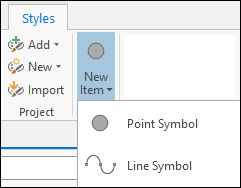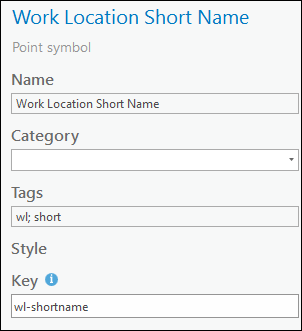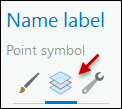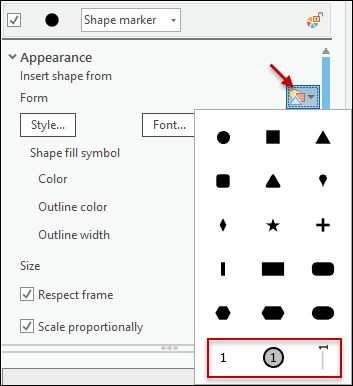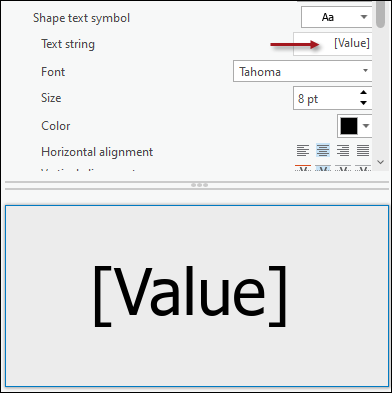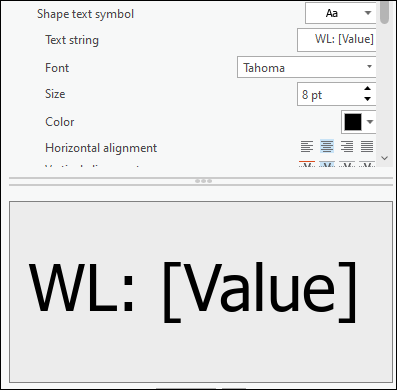Configure Text Symbols in ArcGIS Pro
In addition to symbols, a Design Style can also include text symbols. This is a little different than labeling as the text takes the place of the symbol; it is not text added on top or around a symbol.
In short, this process is quite similar to normal symbols, but instead of creating a line or a point, you insert a text placeholder called “[Value]” that is ready to receive text from an attribute table or directly typed by the end user.
The following image is a preview of the final result:
To include text symbols in your Design Style, follow the steps below. These steps use the Work Location “short name” as an example.
-
In an ArcGIS Pro Project, locate your existing .stylx Design Style. If you have been following the previous topics, it is located in the Catalog pane > Styles folder.
-
Right-click the Design style and choose Manage Style.
-
On the Manage tab, click New Item > Point Symbol or Line Symbol.
NOTE: Which one should I choose? In terms of format (size, font, color, etc.), the options are the same between Point Symbol and Line Symbol. The placement choices are different. Line Symbols offer the ability for the text symbol to follow the angle of the line feature itself. Point Symbols offer placement choices such as top, center, bottom, left, right, and fixed angle. The remaining steps use Point Symbol as the example. -
Click the new Point symbol once. This opens its Description.
-
For the properties fields, follow this guidance:
-
For Name, type a short descriptive name. The Name is up to you and your company, so follow your own naming standards.
-
For Category, Designer XI does not utilize this field, but you might find adding Categories helpful at your organization for other purposes.
If you want a Category, for the first Category you create, you must type the name for the category. For subsequent symbols, the Category name appears in the drop-down, and you do not have to type it anymore. You can choose it from the drop-down.
-
For tags, type logical tags separated by a semicolon. Designer XI does not use the tags in any way, but adding a few tags could be handy for other querying purposes in ArcGIS Pro.
-
For Key, type a succinct, but unique, identifier. The Key can be any unique identifier you want, but read the important notes below to understand more of how it is used.
IMPORTANT:-
Later, this Key is used in Designer XI to match the component to the text symbol, so ensure it is recognizable to you and other administrators. End users do not see the Key.
-
Each Key must be unique within a Design Style.
-
While the Key can have upper and lower case letters, we recommend using only lower case. It is easier to match Keys when both are only lowercase, and it eliminates a potential mismatch between Keys. If you do incorporate different cases, both Keys must match exactly.
-
Similarly, while the Key can have spaces, we recommend not incorporating spaces for the same reason above.
-
-
-
For the sample “Work Location Short Name” text symbol being created in these steps, the properties would like the following image:
-
Click Apply.
-
Click Properties.
-
The text symbol depends on the term (also known as a variable) “[Value]” to be the symbol itself. In the Designer XI application, the configuration looks for the variable [Value], and then inserts whatever text you configure into that variable. Further, you might want to add some text before after the variable to add more description. In short, you need to write a label expression. To do so:
-
Click the Layers icon.
-
Under Appearance, click the icon presets drop-down, then choose a text preset.
IMPORTANT: If you are configuring a Line Symbol, you do not see these choices by default. You first need to add a Marker Layer to your text symbol. To do so, follow these steps: -
In the Text string field, type the word “Value” within square brackets. “Value” must be capitalized.
-
Optionally, add other text before or after the text string.
-
-
Work with the Symbols, Layers, and Appearance options to configure an appropriate text symbol. See the sample for more ideas and examples.
-
Click Apply.


